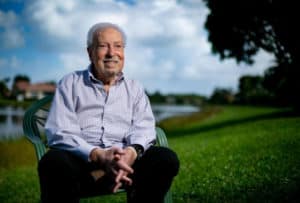Given 3 weeks to live in May ’19, Wellington man is alive and well – thanks to a friend and a timely drug

Diagnosed with the ravaging blood cancer acute myeloid leukemia (AML), Wellington’s Jerry Paull credits a drug called enasidenib that he says saved his life.
WELLINGTON – Jerry Paull thought he had taken his final bow as the curtains were closing on his life of 84 years.
In May 2019, ravaged by an aggressive blood cancer, the long-time music promoter and Wellington resident said his goodbyes, had his estate in order, talked to his pallbearers and picked which songs he wanted played at his funeral, including “Climb Ev’ry Mountain,” from The Sound of Music.
After all, the diagnosis was grim. He had a rapid-growth blood cancer called acute myeloid leukemia (AML) that carries a near-certain death sentence for patients over age 60.
Chemotherapy has long been the standard approach for treating AML, but it rarely eliminates the aggressive cancerous cells.
At first, “I got really depressed,” Paull said, tearing up during a recent sit-down at the couple’s home in Wellington. But climbing into bed one night, he said he felt something like acceptance, and he began to count his blessings.
“I was thinking about my life,” he said. “I look back, and I’ve had a full life.”
Given about three weeks to live, yes, he was ready to welcome in hospice.
But what happened next has the feel of providence – a 180-degree that literally turned his life around. Nearly nine months later, he’s healthy again, living full and happy days in Wellington with his wife, Karen and their dog Nicki.
How was it possible?
“It was like a chain of events, where everything fell into place,” Paull said.
A rapid-growth blood cancer originating in bone marrow, acute myeloid leukemia (AML) fells most of its victims within five years. For patients over 60, the survival rate is only 10 percent or less, and these sufferers almost always succumb to the disease within a year’s time. The American Cancer Society estimates AML will claim nearly 11,200 victims this year.
AML’s “very poor prognosis,” says Paull’s doctor and University of Miami oncologist Justin Watts, isn’t much helped “with the existing standard therapies – especially in an older patient.”
Treatment of AML has changed little in over 40 years, with chemotherapy the primary treatment. But nearly half of AML patients who experience remission through chemotherapy inevitably see the disease recur. In younger, healthier patients, high-dose chemotherapy or bone marrow transplants can reduce the chance of recurrence. But many AML patients – especially the elderly – are not healthy enough to undergo such aggressive treatment.
Jerry Paull was ideal prey for AML. Though lively and active in his 80s, Paull had been diagnosed at 76 with myelodysplastic syndromes (MDS), a range of bone marrow disorders that left him increasingly tired, weak and vulnerable to a litany of other illnesses. He and his wife, Karen, marked the next eight years in weekly trips to Miami for blood work, shots and transfusions, the clock ticking through tallies of white cell numbers, blood platelet counts and ever-low red blood cells.
Karen explains it this way: “Every day of our lives had become a numbers game.”
By this time last year, the Paulls had slowed their work booking musical events at small venues in South Florida to a halt, Karen took over all driving duties as Jerry could get around on his own only with the aid of a walker. Quite social all their lives, the couple grew reluctant to go out — they were exhausted, Jerry’s immune system was low and his spirits even lower.
Then all the counting came to an end. Feeling especially sick and weak, Paull went back to the doctor. A blood workup showed his white cell count had fallen, his blood platelet count was unusually low and his perpetually low red blood cells had dropped off a cliff.
The diagnosis was a killer: he had AML.
But just as it seemed as if he was nearing his final breaths, the sea began to part for Jerry Paull and through it came his friend Daved Bakelman.
“He saved my life,” Paull said.
The two met in 2017, when Paull stopped by the local offices of Papanicolaou Corps For Cancer, the grassroots nonprofit that raises money for cancer research. The Paulls had become Pap Corps members and donated a portion of the proceeds from their promotions work to the South Florida organization. During the short visit, Paull was introduced to Bakelman, then new in his role as Pap Corps’ CEO.
“We had an instant connection,” Bakelman says, “like family.”
The men and their wives frequently meet for dinner and speak often on the phone. When Paull was diagnosed with AML and his health was failing, he called his friend to let him know the end was near – that he’d enrolled in hospice.
Late that night, Bakelman appeared at his door.
“He was yelling at me for giving up too soon,” Paull said. “He said to get a second opinion – ‘you can take advantage of what is at your fingertips.’”
Pap Corps, with more than 22,000 members and 52 chapters across the tri-county area, supports research programs at Sylvester Comprehensive Cancer Center at the University of Miami’s Miller School of Medicine.
As if by divine coincidence, Pap Corps had just awarded Dr. Justin Watts with its Endowed Professorship in Leukemia.
Bakelman’s guidance sent the Paulls to Dr. Watts, one of the world’s leading AML research doctors, whose work had led to the development of a drug that seemed tailor-made for Jerry.
Watts explained that at Sylvester, they conducted a clinical trial of a drug called enasidenib that received accelerated approval from the FDA.
“This drug is given orally, once daily, and inhibits a mutated enzyme called IDH2 that about 10 percent of AML patients have,” he said.
Jerry Paull was among that 10 percent. His own doctor was aware of this rare genetic mutation, but not so about a targeted drug therapy available only since August 2017.
“Jerry was very sick when he first saw me and had enrolled in a hospice program,” Watts said. “The most important decision for me on starting this new drug — while, yes, he had the mutation and I knew the drug could work — was that I also knew the drug wasn’t likely to have significant side effects or cause harm, like traditional chemotherapy does in leukemia, which he could never have tolerated.”
If Paull had come to him pre-enasidenib, Watts said, “there was nothing we could have given to Jerry, who at the time he started treatment was very debilitated and had failed standard treatment.”
Paull said he was told — that fairly quickly after starting enasidenib, his AML would begin to ebb and he would feel better. Still, he says, the pall of his cancer lifted so quickly and so obviously, it was stunning.
“Within six weeks, we knew — the doc said I was in total remission,” Paull said. “I couldn’t accept it for about two weeks.”
Paull says his son, Kevin, finally drove it home for him. “He told me, ‘Dad, you are an effing miracle!’”
From that perspective, Jerry Paull believes he still has work ahead of him — work he feels singularly called to do.
“I want to live my life, do more shows. I want to tell my story now — because I want to help Pap Corps,” he said. “What’s important now is not me – it’s about those who don’t know.”
Those with AML who are fading fast and don’t know about the latest in leukemia research and the possibility that their lives can be saved with a treatment that’s safe, simple and fast.
The medication is not cheap – the daily pills cost about $1,000 each. Paull says Medicare pays part and then his insurance picks up most of the cost.
As for hospice, Paull said it took him a while to cancel because he “just didn’t know” how the treatment was going to turn out – and he’d been in such awful shape. Treatment began in July, and by October the cancer was in remission.
Paull says though his AML is in remission, “that doesn’t mean I’m suddenly 20 years younger.”
He’s still trying to manage his MDS, but now doctor visits take him not to Miami, but to the new Sylvester satellite in Deerfield Beach.
Best of all, he said, he can now share the drive with the love of his life.
Click here for original article.

Leave a Reply